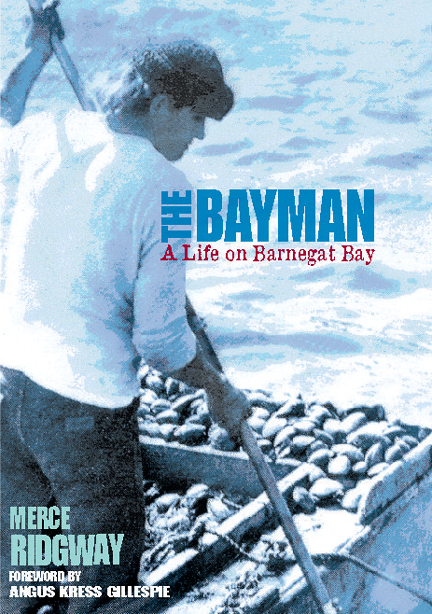Barnegat Bayman
A Hard Life, a Sweet Life Raking in the Harvest
This review appeared in The SandPaper, 7/12/00, and is reprinted with permission. ©2000 Jersey Shore Newsmagazines. It is reprinted in its entirety.
By PAT JOHNSON
It is possible to love a place as much as one loves a family member; to note with pleasure what each passing day brings, to watch for changes with concern, to hurt inside when the place you love is harmed. For the hardy men who spend their lives on the waters of Barnegat Bay and live on the land near it, this love is rarely talked about but deeply felt.
Merce Ridgway’s book, The Bayman, A Life on Barnegat Bay, is a type of love story, full of poignant remembrances of young love, mature respect and righteous indignation over the pollution and habitat loss of Barnegat Bay.
Ridgway grew up duck hunting and fishing on the bay, made his living on it by clamming and crabbing, drew spiritual solace from it.
He grew up in the pines, in Bamber, then in Forked River until his family moved to Lanoka Harbor. He learned from his family the work cycle in the pines. From mossing to blueberrying, clamming, oystering and scalloping, hunting and wood cutting, crab dredging.
Ridgway’s childhood memories of working with his father and family in all these pursuits are the sweetest part of his book.
?By the edge of the field between our house and Grandpop June’s there was an old boat. ... I loved to crawl inside that boat and inhale the fragrance of old cedar. That smell was better than anything I could think of. There is something special about an old boat that has been out on the bay in the salt water when she sets upon the land. Funny thing about that particular scent those old cedar boats have.?
Memories of the heat of a pine needle bed on a summer’s day while the wind sings softly through the oaks and pines, the taste of teaberries, the scent of oak leaves moldering in autumn, Indian Pipes poking up through dark earth, the sting of a breeze that catches sand on a cold winter day — these are only a few sensual memories that are stamped on a native “piney’s” soul.
Ridgway’s father encouraged his son to get an education, do some other kind of work besides clamming and working the bay. He sadly felt the bay was failing and would not sustain another generation. But the call of the bay was too strong for Ridgway, and after a stint in the Marines, Merce returned to Barnegat Bay.
He bought a used garvey for $250. After scraping and caulking her, and getting her motor running, Fin, Fur and Feathers, as she was named, became Merce’s work boat.
?The boat would carry all that I would catch over the rest of my career as a bayman. It would bring me home when other people would not think of going,? wrote Ridgway.
A bayman’s boat is as important to him as a horse was to a cowboy in the Old West. It is not only a means of transportation; it’s his island of safety and rest. After a morning spent in the soft mud of the bay, feeling with expert feet for the knock of a hard clam, lunch time means a walk back to the boat, a few minutes on a hard seat to eat and reflect.
At these times, with his back aching and salt sweat in his eyes, does the bayman reflect on the differences between his humble repast and a three-martini business man’s lunch? A lunch that might (ironically) include the dainty feast of a fresh, half-dozen Barnegat bay clams? Not likely.
At the end of his lunch, the bayman gladly jumps back into the bay, at one with the crabs, the gulls, the blue sky, grateful that he has avoided wearing a suit for yet another day.
He is subjected to the harshest elements. The pleasant, sunny day at the beach can be blistering for those working the bay all day, every day. When thunderheads appear, the bayman may seek the relative safety of dry land, or he may choose to ride out the storm, depending on how much metal he has aboard.
Wintertime is not the end of the bayman’s work season; his search for the elusive bivalve continues through ice and snow. He will be tonging through ice breaks in the bay or searching for ?cut outs,? where the ice has scoured the mud away around islands and exposed the clams. These frozen clams can be easily picked up but must be treated with care if they are to live.
All that stands between the bayman and death in winter’s harsh conditions is a good boat and motor. Ridgway had them. He was fortunate to save others when they capsized in storms.
As a man struggling to make a living from the water, Ridgway was lucky, for he had the dedication and love of his wife, Arlene, his son Tom and his daughters.
?Our children started going out on the bay — family boat rides and picnics — when they were infants in bassinets. I took them out to experience a ride on the water but only on beautiful weather days.?
Son Tom became an expert clammer, and his six sisters all took turns driving the boat while Ridgway counted his clams.
Because clamming can be a dangerous job, clammers in a particular area get to know each other well. Ridgway was a Forked River bayman.
It’s not unusual for one clammer to help another by towing him if his motor has died. There is no reward given or expected. This is part of the unwritten code of the bay. Baymen will lend rakes, baskets and weight belts; they will sometimes share information on where the clams are ?up? (easy to harvest).
But the baymen’s fraternity is stretched to include only those whose conduct reflects their own.
?A man’s word was the most important asset that he owned,? wrote Ridgway. ?Honesty among the men was highly valued. The liar might be tolerated around the dock, but he would have no friends among the core of the baymen who lived our unwritten code. The thief, if such a one were to come around, was not tolerated. To be caught in the act would put the guilty party in fear of his physical safety. Once one was found out, he might as well find a new place to tie up.?
The worse offense to the code of the bay, wrote Ridgway, was the practice of leasing naturally productive areas of the bay to the few. If the cowboy analogy can be tapped again, this is like fencing the prairie.
According to Ridgway’s account, oystering was big in Barnegat Bay in his grandfather’s time and still prosperous for the few in his father’s time. His father and uncles tonged for oysters but were shut out of the oyster leases by the Shellfish Council, whose members divided the leases among themselves, wrote Ridgway. It was that oyster bed leasing and dredging that helped to decimate the oyster in Barnegat Bay, the author tells.
There were other factors influencing the flow and chemistry of the local waters, including the Oyster Creek Nuclear Generating Station and the start-up of the Ciba-Geigy plant at Toms River.
?When a bay dies, the causes should be found, for the safety of all those who live on or around it,? the author said.
Ridgway writes about the meadows (now called wetlands or salt marsh). He can remember a time when he could see cattle grazing on the meadows around Bayville. Fifty years ago when he looked out from Forked River, he could see just one building on the meadows. Now he sees a wall of houses.
Science has accepted that development has contributed to the pollution of the bay from stormwater runoff, and politicians seem willing to look at ways to improve conditions. But Ridgway knew the bay in its essential wilderness; his bitterness at what most call ?progress? can be understood, even sympathized with.
?When there was one house on the meadows, the effect of the bay did not amount to much. Build five thousand houses and the damage is five thousand times as great. We know without a doubt that this is so, yet, as a people, we allow it to go on. We pass laws and regulations with plenty of loopholes so the next guy with some money can still get his dream house with a view of the water.?
Ridgway and his wife now live in West Virginia. The decline of clam stocks in the bay coincided with some health problems and forced him to relinquish his physically demanding work. The high cost of living on the Jersey Shore was also a factor in their choice to move. Now they live in an old farmhouse in a ?holler,? and some of their children and grandchildren have followed.
Though he is now far from his beginnings, Ridgway’s love of Barnegat Bay continues. It continues in his music and in this generous book.

